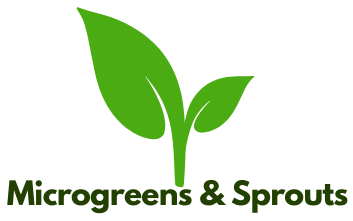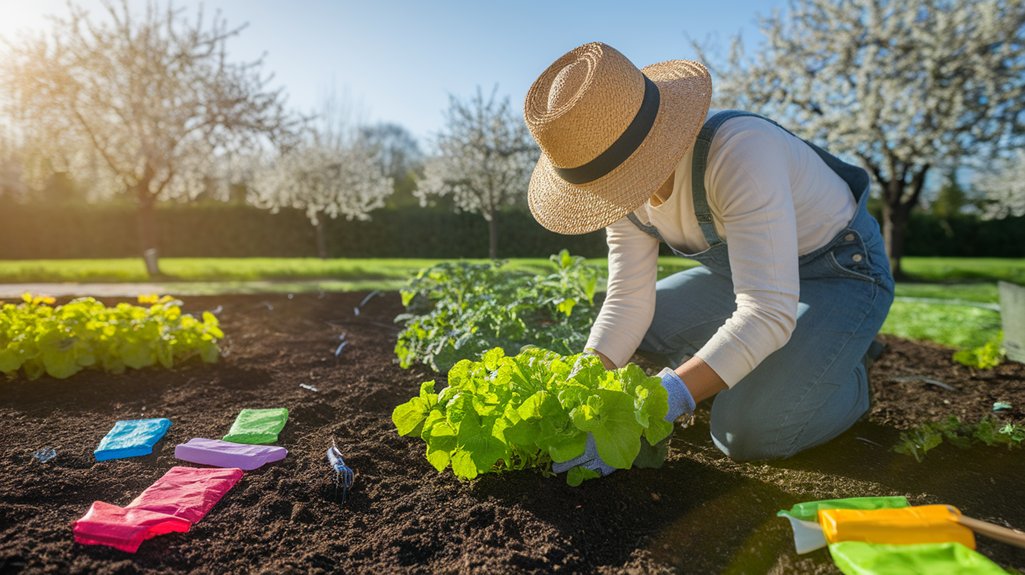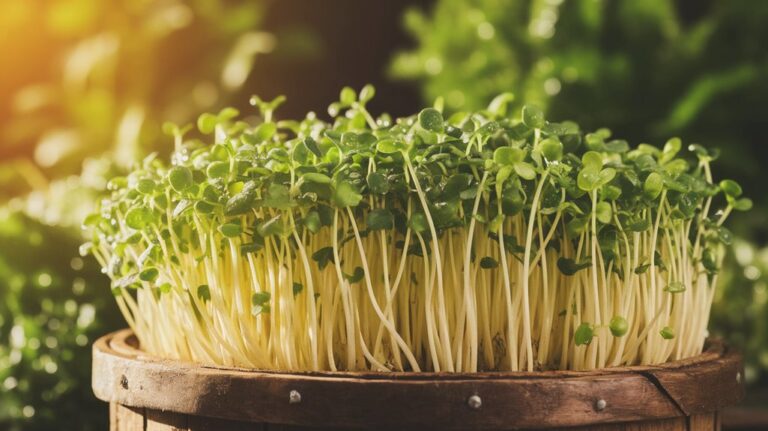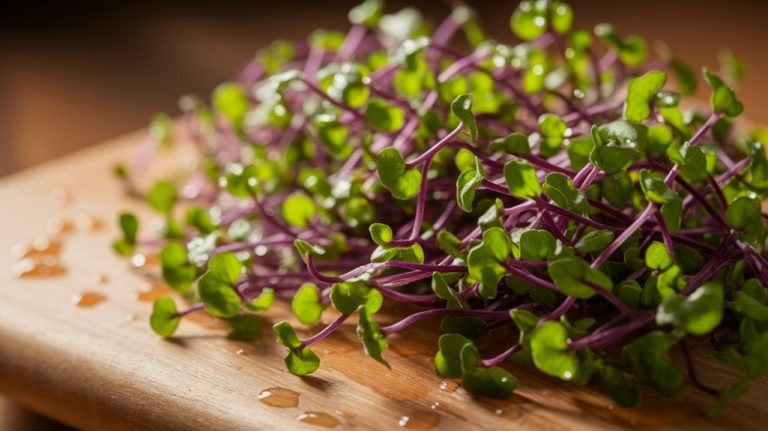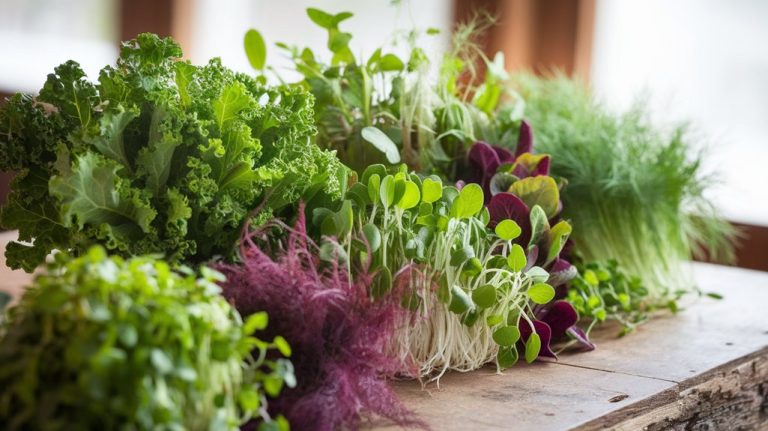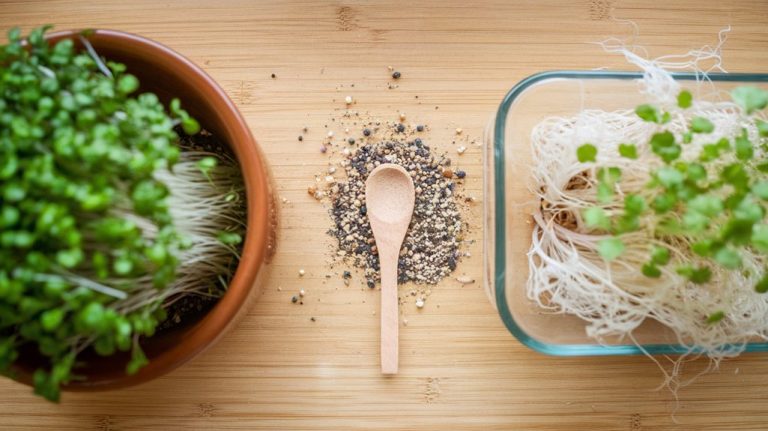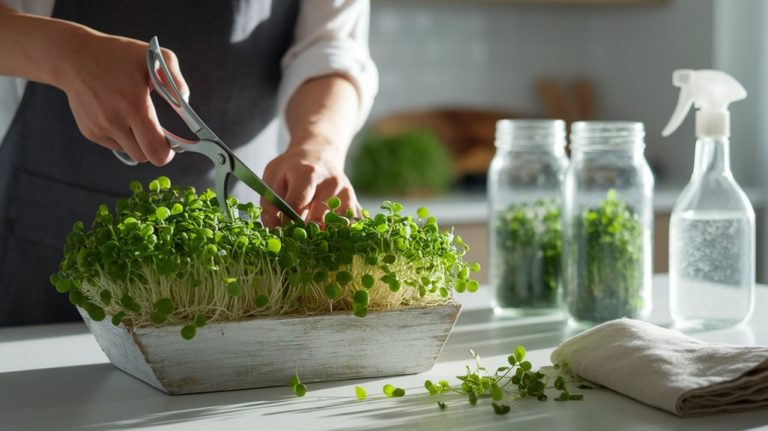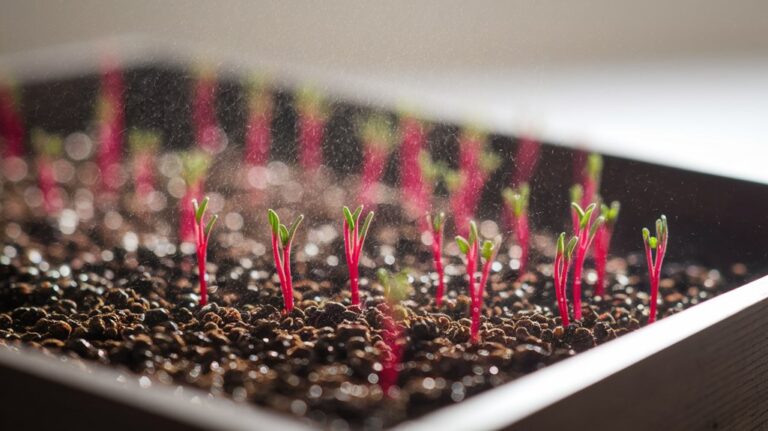Spring Planting Tips for Faster, Bigger Harvests
For faster, bigger harvests this spring, I recommend selecting seeds suited to your climate and timing your planting carefully according to local frost dates. Prepare your soil by testing its pH and adding organic matter. Utilize efficient watering techniques, like soaker hoses, and consider companion planting for natural pest control. Incorporating organic fertilizers can boost nutrients. With these tips, you’ll set your garden up for success, and there’s so much more to explore about maximizing your yield.
Key Takeaways
- Select early-maturing crop varieties to maximize harvest before frost sets in, ensuring a quicker yield.
- Prepare soil by testing pH and mixing in organic matter to enhance fertility and promote healthy growth.
- Use staggered planting techniques to ensure continuous harvesting throughout the season, avoiding a surplus at once.
- Water effectively using soaker hoses or drip irrigation, targeting root areas to promote faster growth with less evaporation.
- Implement pest management strategies, such as introducing beneficial insects and using organic pesticides, to protect and boost plant health.
Selecting the Right Seeds for Your Climate
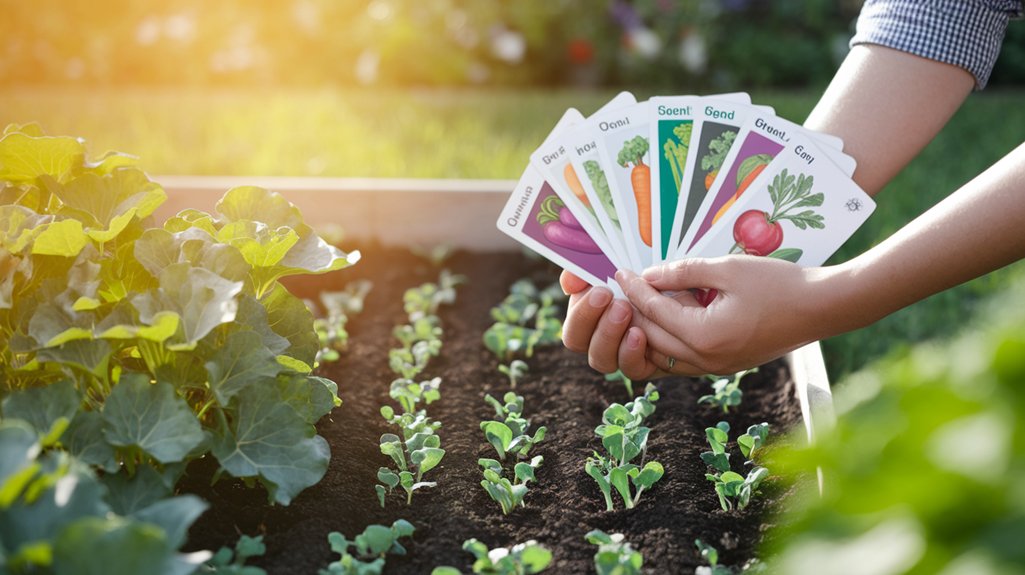
How can I ensure that my garden thrives in my specific climate? First, I research my growing zone, which tells me what plants are likely to flourish. I check the USDA Plant Hardiness Zone Map to find my zone and learn about the temperature ranges.
Next, I choose seeds that are well-suited for my climate’s average rainfall and sunlight. For example, if I live in a hot, dry area, drought-resistant varieties like certain tomatoes or peppers might be ideal.
I also pay attention to the length of my growing season, selecting early-maturing crops if frost threatens. Ultimately, by aligning my seed choices with these factors, I’m setting my garden up for success from the start.
Preparing Your Soil for Optimal Growth
While preparing your soil might seem like a tedious task, it’s actually one of the most crucial steps for ensuring your garden’s success.
Start by testing your soil’s pH and nutrient levels; this gives you a clear picture of what amendments are needed. I usually mix in organic matter, like compost or well-rotted manure, to enhance fertility and improve drainage.
If your soil is compacted, consider aerating it—this allows roots to grow more freely. Don’t forget to remove any weeds or debris, as they compete for nutrients.
Lastly, cover your soil with mulch after planting; it retains moisture and suppresses weeds, creating an optimal environment for your plants to thrive.
Happy gardening!
Understanding Planting Dates and Timing
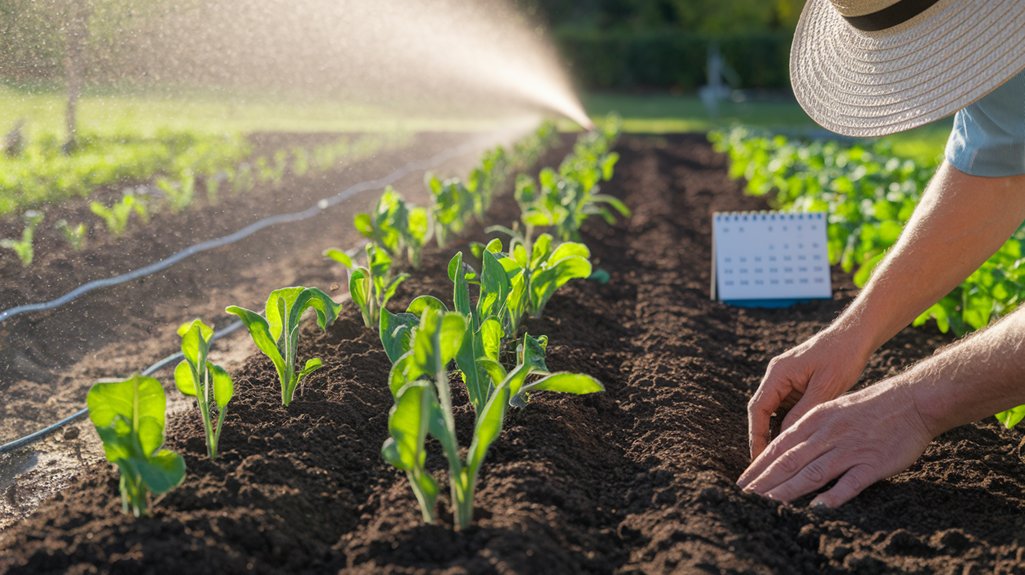
Understanding when to plant your seeds can significantly affect your garden’s yield, especially as different plants thrive in varying conditions.
I’ve learned that knowing your local frost dates is crucial; it helps you avoid planting too early or too late. Cool-season crops, like peas and lettuce, can be sown as soon as the soil is workable, while warm-season crops, like tomatoes and peppers, need warmer soil temperatures.
I also pay attention to the moon phases, as some gardeners swear by planting on specific lunar cycles for better growth. Additionally, grouping plants with similar needs can streamline your planting schedule.
Utilizing Companion Planting Techniques
Companion planting can really enhance your garden’s health and yield.
By strategically pairing plants that benefit each other, I’ve noticed improved growth and pest resistance in my own garden.
Let’s explore some of the best plant combinations and the advantages they offer.
Benefits of Companion Planting
Although many gardeners focus on individual plant needs, I’ve found that utilizing companion planting techniques can significantly enhance the health and productivity of your garden. This method encourages mutually beneficial relationships between plants, fostering an environment that can deter pests, improve soil health, and boost growth.
For instance, when I plant basil alongside tomatoes, I’ve noticed that the basil not only repels harmful insects but also enhances the flavor of the tomatoes. Additionally, some plants can improve nutrient uptake; legumes, for example, fix nitrogen in the soil, enriching it for neighboring crops.
Best Plant Combinations
By applying the principles of companion planting, I’ve discovered some of the best plant combinations that can elevate your garden’s productivity. Certain plants thrive when grown together, maximizing yield and minimizing pests. Here are some combinations I’ve found particularly effective:
| Plant 1 | Plant 2 |
|---|---|
| Tomatoes | Basil |
| Carrots | Onions |
| Cucumbers | Nasturtiums |
| Corn | Beans |
| Peppers | Marigolds |
These pairings not only enhance growth but can also deter harmful insects. For instance, basil boosts tomato flavor and repels pests, while marigolds attract beneficial insects. Incorporating these combinations in my garden has truly transformed my harvests!
Implementing Efficient Watering Practices
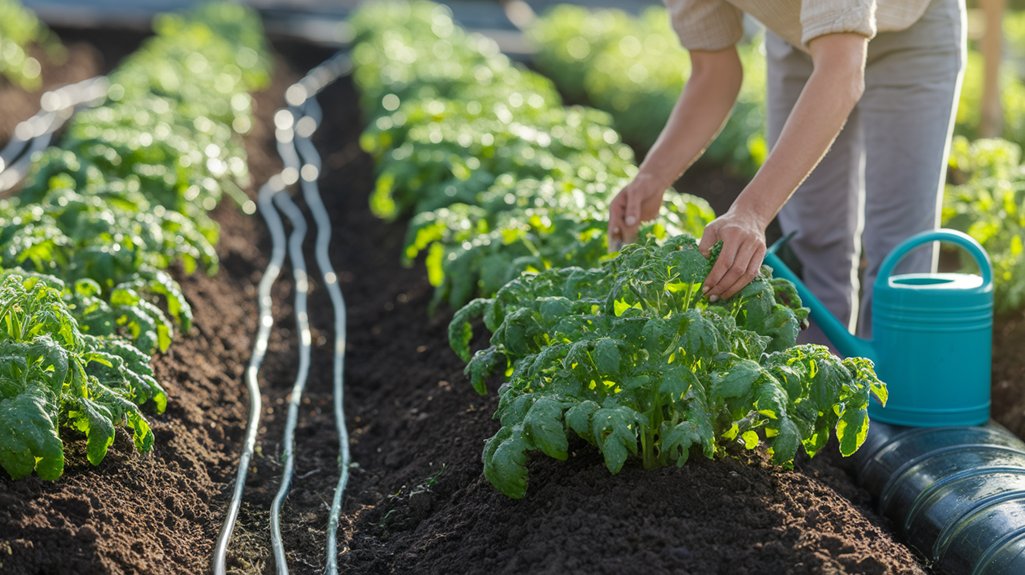
When I think about efficient watering practices, I realize how crucial they’re for the success of my spring garden.
First, I always water early in the morning or late in the afternoon to minimize evaporation. I use a soaker hose or drip irrigation system, which delivers water directly to the plant roots, ensuring deep penetration without waste.
I also monitor soil moisture with my finger; if it’s dry an inch down, it’s time to water. Mulching around plants helps retain moisture and reduces the need for frequent watering.
Lastly, I’ve learned to adjust my schedule based on weather—if it rains, I skip watering.
These practices not only save water but also promote healthier plants and bigger harvests.
Incorporating Organic Fertilizers for Nutrient Boost
After ensuring my plants receive adequate water, I focus on enriching the soil with organic fertilizers to give them a nutrient boost.
Organic fertilizers not only improve soil health but also promote sustainable gardening practices. Here are four types I recommend:
- Compost: It’s packed with nutrients and improves soil structure.
- Worm Castings: These provide a rich source of nitrogen and beneficial microbes.
- Bone Meal: It’s high in phosphorus, great for root development and flowering.
- Fish Emulsion: This liquid fertilizer delivers a quick nutrient boost and is easy to apply.
Incorporating these organic options into my gardening routine has significantly enhanced my plants’ growth and productivity, resulting in bountiful harvests.
Managing Pests and Diseases Naturally
When it comes to managing pests and diseases in my garden, I’ve found that natural methods can be surprisingly effective.
By using companion planting, I can enhance my garden’s defenses, while natural pest deterrents and organic disease control techniques help keep my plants healthy without harsh chemicals.
Let’s explore these strategies together to create a thriving, eco-friendly garden.
Companion Planting Benefits
Companion planting offers a natural approach to managing pests and diseases in your garden, enhancing both plant growth and biodiversity.
I’ve found that pairing certain plants together can create a thriving environment that benefits both. Here are some key benefits I’ve experienced:
- Pest Repulsion: Certain plants, like marigolds, deter harmful insects, protecting neighboring crops.
- Nutrient Sharing: Plants like corn and beans can work together, with beans fixing nitrogen that corn needs.
- Pollinator Attraction: Flowers mixed with vegetables attract beneficial pollinators, boosting fruit set.
- Disease Prevention: Some companions can reduce disease spread by acting as barriers or altering microclimates.
Natural Pest Deterrents
Building on the benefits of companion planting, I’ve discovered various natural pest deterrents that can further protect my garden.
For instance, planting marigolds alongside vegetables not only brightens the space but also repels nematodes and aphids.
I also use garlic and chili spray as a natural repellent; just mix minced garlic and chopped chili with water, let it steep, then spray it on affected plants.
Another effective method is introducing beneficial insects, like ladybugs, which feast on aphids and other pests.
I’ve also found that diatomaceous earth works wonders; sprinkling it around plants creates a barrier against soft-bodied insects.
Organic Disease Control Techniques
While tending to my garden, I’ve realized that managing pests and diseases naturally is just as crucial as using natural deterrents.
I’ve found a few effective organic techniques to keep my plants healthy:
- Companion Planting: Certain plants can repel pests or attract beneficial insects, so I mix them strategically.
- Neem Oil: This natural pesticide helps control a variety of insects and fungal diseases without harming beneficial bugs.
- Baking Soda Solution: A simple mixture of baking soda and water can effectively combat powdery mildew on leaves.
- Regular Monitoring: Keeping a close eye on my plants allows me to catch any issues early, making it easier to manage them.
Tips for Continuous Harvesting Throughout the Season
To ensure a steady supply of fresh produce throughout the growing season, I recommend implementing a few key strategies that focus on timing and plant selection. First, stagger your planting by sowing seeds or transplanting seedlings every few weeks. This way, you’ll avoid a glut of produce all at once. Second, choose varieties that mature at different times. Here’s a quick reference table to help you plan:
| Crop | Days to Maturity | Planting Interval |
|---|---|---|
| Lettuce | 30 | Every 2 weeks |
| Radishes | 25 | Every 3 weeks |
| Beans | 55 | Every 3 weeks |
| Spinach | 45 | Every 2 weeks |
| Zucchini | 50 | Every 3 weeks |
Frequently Asked Questions
How Can I Extend My Growing Season Beyond Spring?
To extend my growing season beyond spring, I’ve found a few effective strategies.
I use season extenders like row covers and cold frames to protect my plants from frost. I also choose varieties that are bred for longer growing seasons.
Additionally, I stagger my planting times to ensure I’m always harvesting something.
I’ve even experimented with indoor gardening during the colder months, which has kept my green thumb active year-round.
What Tools Are Essential for Successful Spring Planting?
When it comes to successful spring planting, I find a few essential tools make all the difference.
A sturdy spade helps me turn soil, while a garden rake levels it out nicely. I always keep a trowel handy for planting seedlings.
A watering can ensures my plants get the hydration they need right away. Lastly, a quality pair of gloves protects my hands while I dig in and enjoy the process.
Can I Plant Vegetables and Flowers Together?
Absolutely, you can plant vegetables and flowers together!
I often mix them in my garden, creating a beautiful and productive space. Companion planting not only maximizes space but also can enhance growth and deter pests.
For instance, marigolds can attract beneficial insects while repelling harmful ones.
Just be sure to choose compatible plants; some veggies like tomatoes and basil thrive together, while others might compete for nutrients.
Happy gardening!
How Do I Know if My Soil Is Healthy?
To know if my soil’s healthy, I check for a few key signs.
I look for dark, crumbly texture, which indicates good organic matter. I also test the pH, aiming for a neutral range around 6 to 7.
Observing earthworms and other beneficial organisms is a good sign too.
Lastly, I conduct a simple jar test to see how well the soil drains.
Healthy soil’s vital for thriving plants, so I pay close attention!
What Common Mistakes Should I Avoid When Planting?
When planting, I’ve learned to avoid a few common mistakes.
First, don’t rush into planting before the last frost—check your local frost dates.
It’s also crucial not to overcrowd your plants; they need space to grow.
I’ve forgotten to prepare the soil properly, which leads to poor growth.
Lastly, I’ve overlooked watering needs, so keep an eye on moisture levels.
Each of these can significantly impact my garden’s success!
Conclusion
In conclusion, by selecting the right seeds, preparing your soil, and timing your planting, you can set yourself up for a bountiful harvest. Utilizing companion planting and efficient watering practices will further enhance your garden’s productivity. Don’t forget to incorporate organic fertilizers and manage pests naturally for healthier plants. With these tips in mind, you’ll be well on your way to enjoying continuous harvests throughout the season. Happy planting!
